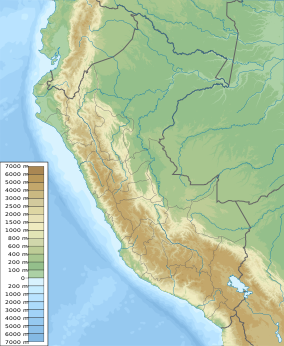Alto Mayo Protection Forest
| Alto Mayo Protection Forest | |
|---|---|
| Bosque de Protección Alto Mayo | |
IUCN category VI (protected area with sustainable use of natural resources) | |
 Alto Mayo Forest. | |
| Location | San Martin and Amazonas |
| Coordinates | 5°38′35″S 77°42′00″W / 5.643°S 77.70°W[1] |
| Area | 1,820 km2 (700 sq mi; 182,000 ha) |
| Established | July 23, 1987 |
| Governing body | SERNANP |
The Alto Mayo Protection Forest (Spanish: Bosque de Protección Alto Mayo) is a place in Peru. It is in Rioja and Moyobamba Provinces in San Martin. A small part of the forest is in Rodriguez de Mendoza Province, in Amazonas.[2] This area preserves a portion of the tropical yungas forest in the upper Mayo River basin, while protecting soil and water from erosion by deforestation, as the area is the water supply of populations in the Mayo valley.[2][3]
History
[change | change source]The government of Peru made Alto Mayo into a national forest in 1963. The law was Law No 442. In the 1970s, many people started to go to the forest and cut down the trees anyway.[4] Other people built a road through the national forest and to go there to kill yellow-tailed woolly monkeys to eat.[4] The government tried to make this better by changing the law: They would not allow people to cut down trees or hunt in the higher part of the valley but people could build farms in the lower valley.[4]
In 1974, scientists found yellow-tailed woolly monkeys in the park, so more scientists went there to study it.[2][4]
In 1977, the Ministry of Agriculture tried to make the rules about the park clearer.[4]
In 1979, people opened a road from the eastern forest to the Pacific ocean (Carretera Marginal de la Selva). The same year, the government allowed people to use more of the park.[2][4]
Between 1974 and 1983, scientists studied the living things in the park, and they all said that the park should be a protected place.[4]
The government started to make the park clear in 1984, and it made a decree in 1987.[4]
Geography
[change | change source]The park has 1,820 square kilometres (450,000 acres) of forest next to the River Mayo basin.[2] The protected area also covers part of Moyobamba district within the province of Moyobamba; Rioja, Elias Soplin Vargas, Nueva Cajamarca, Awajun and Pardo Miguel districts within the province of Rioja; and a small part of the Vista Alegre district, within the province of Rodriguez de Mendoza, in the neighboring region of Amazonas.[5]
There are mountains in the park. It is in the eastern part of the Andes. The park land is steep. Some places are as steep as 70% up and down.[2]
The park is part of the place where rainwater flows into the river Mayo. Eleven of the smaller rivers that go into the Mayo start in the Alto Mayo Protected Forest.[2]
Living things
[change | change source]The Alto Mayo Protection Forest protects part of the Peruvian Yungas ecoregion.[2]

Animals
[change | change source]Many mammals live in the park, for example the yellow-tailed woolly monkey, the spectacled bear, the cougar, the Peruvian night monkey, the Rio Mayo titi, and the giant armadillo.[3]
Many birds live in the park, for example, the Andean cock-of-the-rock, the oilbird, the king vulture, the equatorial greytail, the long-whiskered owlet, the swallow-tailed kite, the razor-billed curassow, the Andean guan, the speckled chachalaca, the blue-grey tanager, and the white-throated toucan.[2][3]
Plants
[change | change source]Many plants live in the park, including many trees: cedro (Cedrela odorata), requia (Guarea trichilioides), rifari (Miconia longifolia), ojé (Ficus insipida), cetico (Cecropia sp.), uvilla (Pourouma cecropiifolia), tornillo (Cedrelinga cateniformis), cascarilla (Cinchona pubescens), palo seco (Alseis peruviana), huamansamana (Dipteryx alata), amasisa (Erythrina fusca), quinilla (Manilkara bidentata), marupa (Simarouba amara), yurac ciprana (Guatteria hyposericea), zapote (Quararibea cordata), guayacán (Tabebuia ochracea), catahua (Hura crepitans), mashonaste (Clarisia racemosa), moena negra (Ocotea sp.); orchids like: Phragmipedium boisserianum, Masdevallia vargasii, etc.[2][6]
Environmental issues
[change | change source]Farmers still come to build farms inside the park, even though that is against the law. People also go into the park to take wild orchid flowers and animals to sell, to cut down trees to get wood to build with, and people fishing too much.[2]
References
[change | change source]- ↑ "Alto Mayo Protection Forest". protectedplanet.net. Archived from the original on 2013-04-04. Retrieved 2024-08-25.
- ↑ 2.00 2.01 2.02 2.03 2.04 2.05 2.06 2.07 2.08 2.09 2.10 "Alto Mayo Protection Forest - Park Profile - General information". parkswatch.org. Retrieved 2017-05-11.
- ↑ 3.0 3.1 3.2 "Alto Mayo - Servicio Nacional de Áreas Naturales Protegidas por el Estado". www.sernanp.gob.pe (in Spanish). Archived from the original on 2016-02-04. Retrieved 2016-01-31.
- ↑ 4.0 4.1 4.2 4.3 4.4 4.5 4.6 4.7 Plan Maestro del Bosque de Protección Alto Mayo 2008 – 2013 (PDF) (in Spanish). INRENA. 2008. pp. 14–16.[permanent dead link]
- ↑ Plan Maestro del Bosque de Protección Alto Mayo 2008 – 2013 (PDF) (in Spanish). INRENA. 2008. p. 24.[permanent dead link]
- ↑ "Collections from the Alto Mayo Expeditions". www.sacha.org. Retrieved 2017-05-11.
